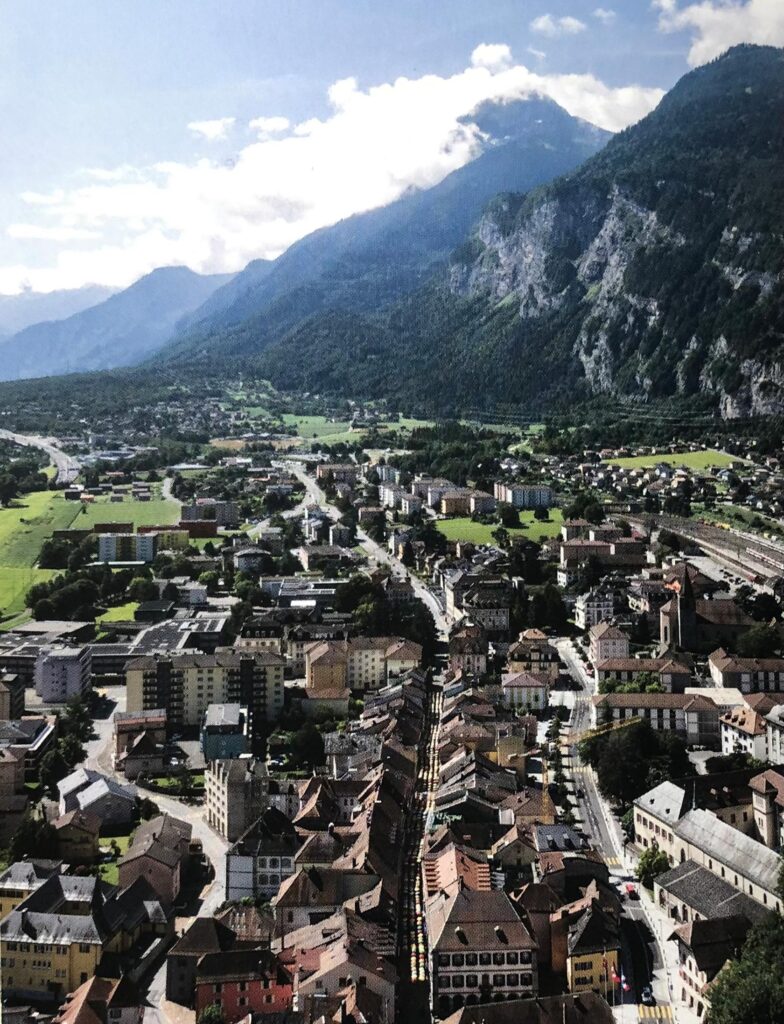
SAINT-MAURICE-EN-VALAIS, Switzerland — At the dawn of Christendom, an African general fighting for Rome faced a marauding band of Goths in a narrow river pass in the Swiss Alps. The battle raged for hours by the eastern bank of the Rhone, below the soaring granite walls of the defile near Lake Geneva where the river begins its long passage to the Mediterranean.
Maurice, commander of the Theban Legion from the Upper Nile, led his 6,666 men in the front ranks of the imperial force, the clash of swords and shields and the groans of the wounded and dying echoing off the stone escarpments.

A medieval statue from northern Germany depicts St. Maurice. PHOTO: ERINT IMAGES
Emerging victorious to secure the safety of Roman settlements and trade routes winding through the rich farmlands to the south, Maurice paused to lead his soldiers in a prayer of thanks to Christ.
The relatively minor confrontation in a far-off Roman possession in the year A.D. 292 may have passed nearly unnoticed in history if not for what happened next: Maurice received a command from Emperor Maximian to offer a sacrifice of thanks to the pagan gods but refused the order, unwilling to compromise his faith.
The general’s disobedience posed a quandary to the emperor. Maurice had served honorably and bravely, marching from the gates of Rome to the wilderness of Gaul in present-day France to suppress rebellions on the fringe of the beleaguered empire. His legion of African soldiers, skilled and experienced, served as effective shock troops against the enemy.
But dissent could not be tolerated in the ranks. The emperor ordered a decimation of the legion — one-tenth put to death by the sword. Still Maurice refused. Another decimation was ordered. After the second refusal, Maximian commanded that the entire legion be slain.
Maurice was said to have placed his head on a broad stone slab to calmly meet his maker — a stone that now serves as the altar-top in a chapel built on the site of the legion’s sacrifice.
The story of the centurion’s martyrdom spread throughout the Christian world and sparked a 1,700-year unbroken history of veneration. Within a few centuries of his death, Maurice was canonized and an abbey was built in this small Swiss village to commemorate his sainthood.
A full cult around Maurice emerged in the medieval era, supported by Frederick II, the crowned head of the Holy Roman Empire in the 12th century.
“Maurice was an important figure to Frederick II,” said Paul Kaplan, an art historian who teaches at the State University of New York in Purchase and is considered the leading expert on depictions of Maurice. “He brought African soldiers to his court and revered Maurice for his service in the Roman Empire, his faithful Christianity and his renown as a military leader.”
A remarkable stone statue from the era depicts Maurice in armor and chain mail with strong African features.
In the centuries after the collapse of the Roman Empire and through the Middle Ages and the early Renaissance, St. Maurice’s African heritage was considered no more unusual than that of other prominent figures in Christianity, like St. Augustine of Hippo, born in present-day Libya, or Simon of Cyrene, who was summoned from the crowd in Jerusalem to help the exhausted Jesus carry the cross to the crucifixion.
But Maurice’s star in the firmament of sainthood began to dim after holy wars in Europe diminished the role of post-Biblical saints among Protestant worshippers.
Some students of history, like Mario Valdes, a Boston-based documentary filmmaker, argue that representations of Africans as objects of reverence began to fade as the slave trade in the Renaissance period became a nearly exclusive commerce in Africans. Depicting Blacks as religious and cultural heroes did not serve the cognitive dissonance needed to justify the trade in African men, women and children.
“Tragically, there is, of course, an all-too-obvious reason why this saint is still virtually unknown today: the involvement of most European nations in the slave trade, which would not have tolerated, much less encouraged, the devotion to a Black African who had once been nothing less than the personification of the military might and religious ambitions of what was once the greatest power in western history,” Valdes wrote in a recent article.
Also dimmed by the same forces, argues Valdes, is the association of Maurice with the “Spear of Destiny,” the lance used by the soldier Longinus to pierce the side of Christ on the cross. The relic, now residing in Vienna, was incorporated in the scepter of the Holy Roman emperor and was said to have been carried by Maurice into battle. Another story, says Valdes, mostly forgotten.
But here in this mountain village, hemmed in by towering stone walls overlooking picturesque farms, Alpine meadows and the Rhone River, St. Maurice is fully embraced as a Black saint from a culture that embraced Christ within a generation of his death on Golgotha.
The Abbey of St. Maurice was founded in this small Swiss town in the sixth century and has held services every day in remembrance of its patron saint for over 17 centuries. Maurice’s September 22 feast day is a major celebration here as well as in the hundreds of parish churches and towns in France, Italy, Germany and Switzerland named for Maurice — including St. Moritz, the chic ski resort in southeastern Switzerland.
During a recent morning visit to the abbey, monks in white soutanes, led by a priest waving an incense dish, processed up the nave of the abbey’s main chapel, filling the stone vault with their sonorous Gregorian chants.
The abbey, built on the ruins of a Roman shrine dedicated to the god Mercury, came under the patronage of King Sigismund of Burgundy in 515. The dynastic line maintained control of the monastery until it passed in the aftermath of an 11th-century battle to the House of Savoy, which controlled much of the upper French Alps and what is now western Switzerland.
The grounds of the abbey include excavations showing walls from the Roman era — when the settlement was known as Agaunum — as well as crypts, cloistered courtyards, a 1,500-year-old baptismal font, and priceless gold and silver relics.
The nearby Chapel of the Martyrs in Verolliez, a short walk from the abbey, is a place of quiet reflection, with the oversized altar and stone slab dominating the small, vaulted chamber. Here, a visitor can kneel and meditate, with no sound but the rushing flow of the nearby Rhone and the echo of history that brought an African general to these foreign fields to lay down his life for his faith.


![Banner [Virtual] Art Gallery](https://baystatebanner.com/wp-content/uploads/2024/04/Cagen-Luse_Men-at-store-e1713991226112-150x150.jpg)

![Banner [Virtual] Art Gallery](https://baystatebanner.com/wp-content/uploads/2024/04/Cagen-Luse_Men-at-store-e1713991226112-848x569.jpg)

